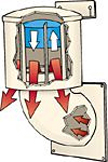These often overlooked sources of heat loss and air leakage can cause heat to pour out and the cold outside air to pour in - costing the homeowner higher heating bills, causing cold drafts, and wasting energy.
Air leaks are the largest source of heating and cooling loss in the home. Air leaks occur through the small cracks around doors, windows, pipes, etc. We can apply caulk and weatherstripping to these areas to minimize heat loss and cold drafts.
But what can you do about the three largest "holes" in the home - the folding attic stair, the fireplace, and the clothes dryer? Here are some tips and techniques that can easily, quickly, and inexpensively seal and insulate these holes.

Attic Stairs
Does your customer's home have a folding attic stairway? When attic stairs are installed, a large hole (approximately 10 square feet) is created in the ceiling. The ceiling and insulation that were there have to be removed. And what is installed to cover this opening? A thin, unsealed, uninsulated sheet of plywood.The attic space is ventilated directly to the outdoors. In the winter, the attic space can be very cold, and in the summer it can be very hot. And what is separating the conditioned house from the unconditioned attic? That thin sheet of plywood.
Often a gap can be observed around the perimeter of the door. Try this yourself: turn on the attic light and shut the attic stairway door. Do you see any light coming through? These gaps can add up to a significant opening where heated/cooled air leaks out 24 hours a day, 7 days a week, 52 weeks a year. This is like leaving a window open all year round.
An easy, low-cost solution to this problem is to add an attic stair cover. An attic stair cover provides an air seal, reducing the air leaks. Add the desired amount of insulation over the cover to restore the insulation removed from the ceiling.

Fireplaces
Approximately 100 million homes in North America are constructed with wood or gas burning fireplaces. Unfortunately, there are negative side effects that the fireplace brings to a home, especially during the winter home heating season. Fireplaces are energy losers.Researchers have studied this to determine the amount of heat loss through a fireplace, and the results are surprising. One research study showed that an open damper on an unused fireplace in a well-insulated house can raise overall heating energy consumption by 30 percent.
A recent study showed that, for many consumers, their heating bills may be more than $500 higher per winter just due to the air leakage and wasted energy caused by fireplaces.
Why does a home with a fireplace have higher heating bills? Hot air rises. Heated air leaks out any exit it can find, and when warm heated air is drawn out of the home, cold outside air is drawn in to make up for it. The fireplace is like a giant straw, sucking the heated air from a house. Again, this is like leaving a window open year round.
A simple solution to this problem is to add a fireplace draftstopper. A fireplace draftstopper is an inflatable pillow that seals the damper, eliminating air leaks. The pillow is removed whenever the fireplace is used, and reinserted when the fireplace is not in use.

Clothes Dryer Exhaust Ducts
Have you ever noticed that the room containing the clothes dryer is the coldest room in the house? Ever wonder why? The clothes dryer is connected to an exhaust duct that is open to the outdoors. In the winter, cold air leaks in through the duct, through the dryer, and into the house, while heated air just pours right out.Dryer vents use a sheet metal flapper to try to reduce this air leakage. This is very primitive technology that does not provide a positive seal to stop the air leakage. Compounding the problem is that, over time, lint clogs the flapper valve causing it to stay open. Once again, this is like leaving a window open.
An inexpensive solution to this problem is to add a dryer vent seal. A dryer vent seal will reduce unwanted air infiltration, and keep out pests, bees, and rodents as well. The vent will remain closed unless the dryer is in use. When the dryer is in use, a floating shuttle rises to allow warm air, lint, and moisture to escape.
Mark D. Tyrol is a professional engineer specializing in the cause and origin of construction defects. He has developed several residential energy conservation products including an attic stair cover and a fireplace draftstopper. For more information, visit www.batticdoor.com.
Publication date: 01/24/2005

Report Abusive Comment